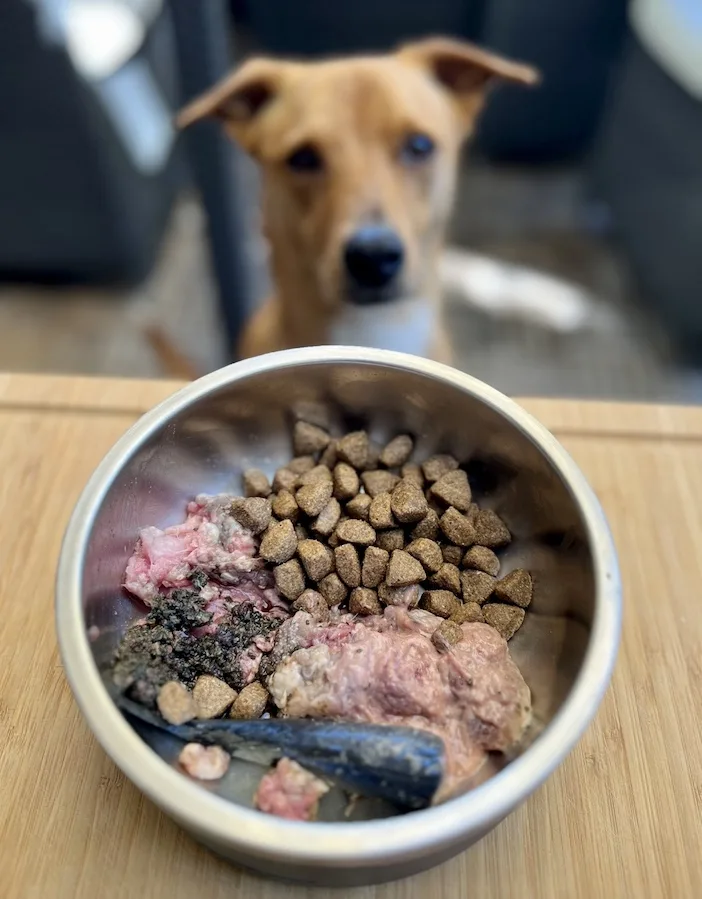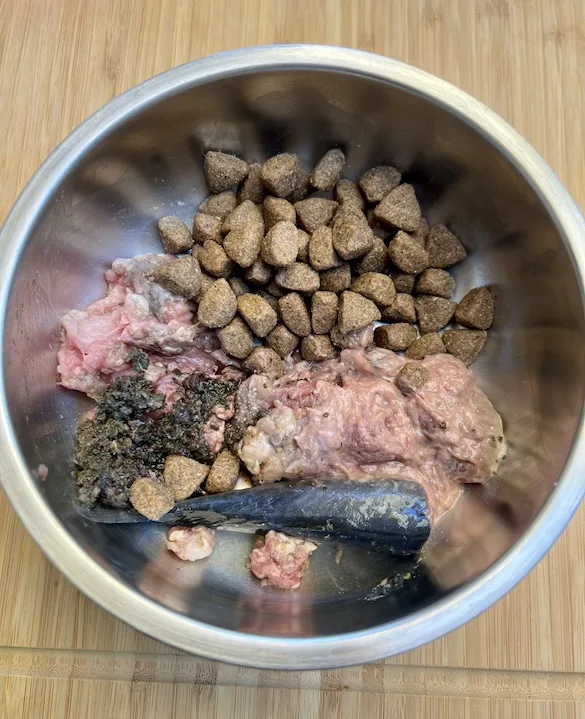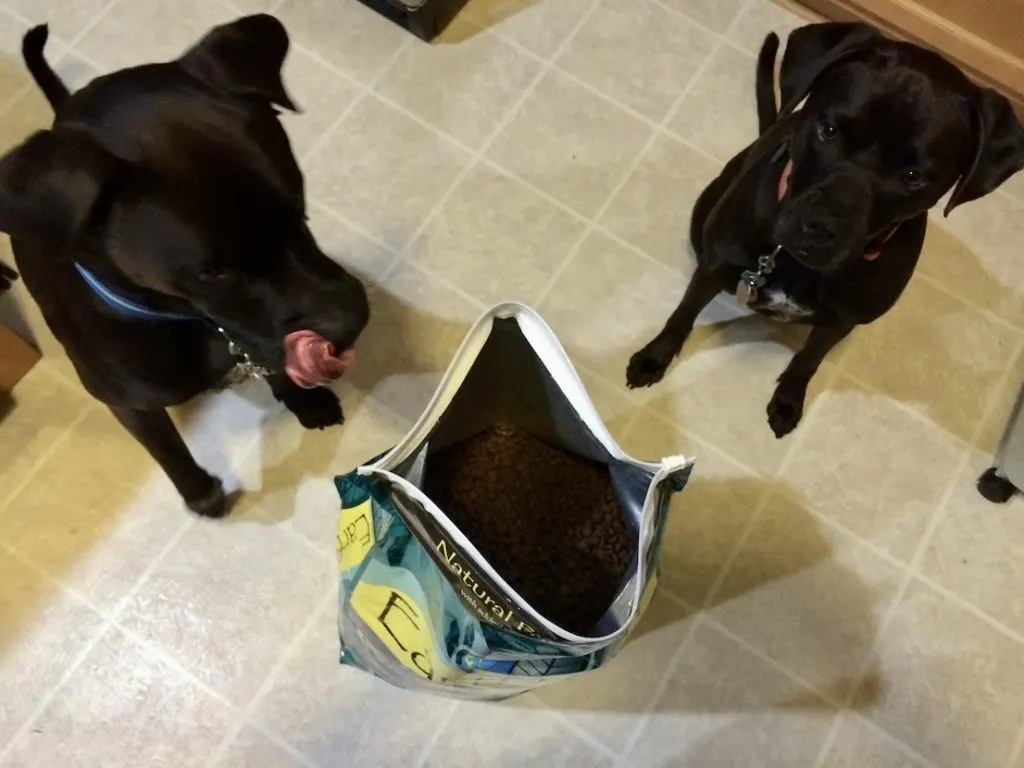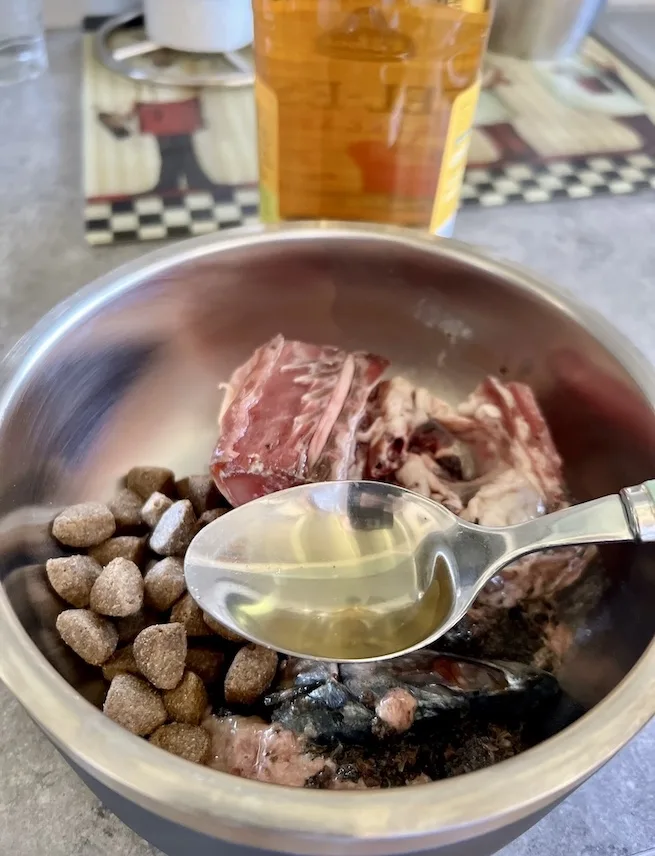Are you thinking about feeding your dog raw and kibble?
Whatever your reason may be for looking into this combination feeding approach, the general answer is yes, you can feed your dog raw and kibble.
However, it’s important to understand that there are some factors to consider before you start mixing the two foods.
So in this blog post, I’ll explain the benefits and drawbacks of both raw and kibble, as well as how to go about combining them safely.
Separate meals of kibble and homemade raw dog food
Understanding the Raw Food Diet
I personally have been feeding raw dog food since 2015.
It’s a type of diet that involves feeding dogs a variety of raw ingredients that mimic the diet of their wild ancestor, the wolf.
Since dog and wolf DNA only differs by 0.8%, dogs are equipped to handle raw meat as well as raw bones no problem.
Having said that, that’s exactly what raw dog food consists of: Raw meat, edible bones, (secreting) organs, and plant matter.
Here are some key points to be aware of:
- Raw muscle meat is the primary component of a raw food diet. It includes specific cuts like hearts, gizzards, lungs and breast meat from various protein sources such as beef, poultry, lamb, fish, etc.
- Raw pliable bones that have meat attached are an important component of the raw food diet. Chicken legs, turkey necks and duck feet are examples of such raw meaty bones. They provide essential nutrients, dental benefits, and mental stimulation for dogs.
- Secreting organ meats like liver, kidney and spleen are essential in a raw food diet due to their rich nutrient profiles.
- Some raw food diets incorporate small amounts of plant matter like vegetables, fruits, nuts and seeds. These can be pureed or finely chopped and include options like leafy greens, carrots, apples, berries, chia seeds and sunflower seeds. They provide fiber, antioxidants, and additional nutrients.
Benefits of Raw Dog Food
Raw dog food is made with fresh foods that are minimally processed and chock full of essential nutrients and digestive enzymes.
Since chewing raw meaty bones is a big part of raw feeding, it helps support healthy dog teeth, jaws and gums.
The nutrient-dense nature of raw dog food contributes to healthier skin and a shinier coat.
Also, dogs with sensitive stomachs or food allergies can benefit enormously from a raw dog food diet because it eliminates common allergens.
Many dogs also experience improved digestion, reduced gastrointestinal issues, and smaller stools.
Drawbacks Of Raw Dog Food
One of the key challenges of a raw food diet is ensuring proper nutritional balance.
That’s particularly true when you’re making your own homemade raw dog food as opposed to buying premade raw from brands like Darwin’s.
Additionally, raw meat poses a higher risk of bacterial contamination compared to kibble.
Handling raw meat can increase the risk of bacteria such as Salmonella, which can be harmful to humans (but not to healthy dogs thanks to their acidic stomach environment).
Preparing a raw food diet also requires time, effort, and careful meal planning. It involves sourcing high-quality ingredients, (optional) grinding, portioning, and freezing meals.
I’ve been making my own raw dog food since 2016 and spend about 2 hours per week on raw dog food meal prep.
Feeding raw dog food can also be more expensive compared to kibble, regardless of whether you buy premade raw or make your own – especially if you’re feeding multiple medium to large size dogs.
Overview of Commercial Dog Kibble
As you may know, kibble is typically made from a combination of ingredients such as meat or meat by-products, grains (such as corn, wheat, or rice), vegetables, fruits, and various synthetic add ons.
The ingredients are processed at high heat and extruded into small, dry pellets known as kibble(s).
Benefits of Feeding Kibble
Kibble brands aim to provide balanced and complete nutrition for dogs.
They are formulated to meet the nutritional requirements established by regulatory authorities, such as the Association of American Feed Control Officials (AAFCO) in the United States.
The main advantage of dry kibble is that it offers convenience to pet owners: It’s easy to just pour from the bag and it also has a long shelf life.
Overall, it’s easier to handle, store, and serve than raw dog food.
Drawbacks of Kibble
However, kibble has a significantly lower moisture content compared to raw dog food which can be problematic in dogs who don’t like to drink a lot of water.
After all, dogs have a natural instinct to obtain hydration from their food, and a dry diet does not provide sufficient moisture.
The reason why kibble has a much lower moisture content is that the processing methods used to create kibble involve high heat and pressure.
This also degrades the quality and quantity of all nutrients.
Essential vitamins and enzymes are lost during the manufacturing process, and require synthetic supplementation to meet nutritional requirements.
Also, not all commercial dog kibble brands are created equal.
Some lower-quality brands use low-cost ingredients, fillers (such as corn, wheat, or soy), and artificial additives to bulk up the product.
These ingredients don’t provide optimal nutrition, are harder for dogs to digest and can cause allergies that result in itching and scratching.
Enter Mixed Feeding: Combining Raw and Kibble
As I laid out, raw and kibble each have their respective benefits and drawbacks.
That’s why feeding a mix of raw and kibble makes it possible to draw on the benefits of both.
If you’re new to raw dog food, this mixed feeding approach can be a good way of easing your dog (and yourself!) into the concept of raw dog food.
How Much Raw And Dry Food Should I Feed My Dog During The Transition?
When you’re switching your dog from kibble to raw, add more and more raw dog food to the kibble your dog eats during a period of 7-10 days.
At the same time, decrease the amount of kibble until your dog eats only raw dog food.
A combined meal of raw and kibble
How To Feed Raw And Kibble
But even if you’ve been feeding just raw dog food for a while, you may be thinking about supplementing it with some kibble to save money.
Another reason could be that you’re looking for partial convenience if you’re not the only one feeding your dog.
For example, if your spouse would rather scoop kibble from the bag while you don’t mind handling raw dog food.
Maybe you don’t trust your own ability to make balanced raw dog food and want to do half raw half kibble to ensure your dog gets all the nutrients they need.
Or maybe you’re just looking to add a little variety to your pup’s bowl to entice your picky eater to eat.
I personally have combined raw and kibble when I’m on the road with my dog and only have limited freezer space.
Tip: Another alternative to the convenience and long shelf life of kibble is freeze-dried raw. I’ve also fed a combination of kibble and freeze-dried raw when on the road.
But whatever YOUR reason, here’s how to go about it!
Proper Portions For Raw And Kibble
First of all, you’ll want to be aware of the portion sizes for your dog’s size, age, and activity level: Are you feeding a puppy, an adult dog or a senior pup?
Puppies, pregnant dogs and working dogs require a lot more energy = food than less active adult dogs and senior dogs who‘ve slowed down.
So depending on their respective needs, determine the appropriate portions of raw food and kibble for your dog.
That’s why you’ll want to read the recommended feeding label on your kibble bag as well as the feeding instructions on the raw dog food packaging.
If you make your own raw dog food, know how much raw your dog needs to eat on a daily basis.
That way, you can reduce the amount according to how much kibble you’re feeding along with raw.
Here’s the formula for healthy adult dogs: TBW (Target bodyweight) / 100 x 2.5%
If your healthy adult dog is at their target body weight of 50 lbs, divide that number by 100, then multiply the result with the maintenance percentage of 2.5
The result is 1.25 lb = 20 oz of raw dog food per day.
How Do You Feed 50% Raw And 50% Kibble?
If you’re looking to feed 50% raw and 50% kibble, only feed that dog half of their daily raw dog food allowance, 10 oz.
Assuming that a 50 lb dog eats 2 cups of kibble per day, only feed half, 1 cup.
So you could feed that 50 lb dog 10 oz of raw and 1 cup of kibble per day.
One option is to feed separate meals of kibble and raw, and another option is to just mix both together in one bowl.
Combining raw and kibble in one meal
Nutritional Requirements For Feeding Raw And Kibble
Additionally, it’s important to maintain a balance between kibble and raw to ensure your dog receives a complete and balanced diet overall.
If you choose to prepare raw dog food at home, research balanced raw food recipes or consider pre-packaged raw food options like the ones from Darwin’s.
Raw food recipes should include the appropriate ratios of muscle meat, secreting organs, raw meaty bones, and optional plant matter to provide a wide range of nutrients.
That’s less important with premade raw dog food as that’s already put together for you.
But if you’re making DIY raw dog food at home, you’ll need to do some math.
Figure out how much of which cut of meat your dog usually eats:
Of their daily raw dog food allowance, you usually feed:
- 70% in muscle meat (including oily fish)
- 10% in secreting organs (5% liver, 5% other secreting organs)
- 10% in raw meaty bones
- 10% in plant matter
If you’re following a PMR approach, you’re not feeding plant matter and would need to up the muscle meat amount to 80%.
But either way, once you know how much of the individual components your dog eats per day, you’ll have to adjust them according to how much kibble you’re feeding.
If you feed 50% kibble, only feed 50% of the different cuts of raw meat.
If you feed 75% kibble, only feed 25% of the raw meat cuts, etc.
Select High Quality Kibble And A Reputable Raw Dog Food Brand
Choose a high-quality commercial kibble brand that meets the nutritional standards set by regulatory authorities, such as AAFCO in the US.
Look for kibble that contains real meat as the primary ingredient, avoids fillers like corn and other grains, and provides a well-balanced nutrient profile.
For example:
I fed my dogs Missy & Buzz Earthborn kibble while making the switch from kibble to raw
If you don’t make your own raw meals, choose raw dog food from a reputable brand like Darwin’s Natural Pet (made with vegetables) or Raw Paws Pet Food (mostly without vegetables)
Their recipes are formulated by veterinary nutritionists, holistic vets and animal dietary nutritionists.
That said, it’s important to rotate between different types of meat (poultry, beef, lamb, fish) in order to provide a broad range of nutrients.
Monitor Your Dog’s Health
When you’re feeding raw and kibble, regularly monitor your dog’s weight, body condition, energy levels, coat condition, and overall well-being.
If you notice any signs of nutritional deficiencies or excesses, consult with your (holistic) veterinarian to make necessary adjustments to their diet.
Depending on your dog’s specific needs, your veterinarian may recommend certain nutritional supplements to ensure complete and balanced nutrition.
This could include omega-3 fatty acids, joint supplements, or specific vitamins and minerals.
Be Aware Of Digestive Issues
Many dogs have no problem eating raw and kibble together, and my pup Wally is one of those.
For those guys, it’s perfectly fine to combine a meal of kibble and raw dog food at any given meal.
However, some dogs have overly sensitive stomachs and do better with separate meals of raw and kibble.
The reason for that may be that kibble and raw dog food digest at different rates.
Can I Feed My Dog Raw In The Morning And Kibble At Night?
If your pup is one of those dogs, you can try feeding them raw in the morning and kibble at night, or vice versa.
Tip: Try adding some ACV (Apple Cider Vinegar) to your dog’s bowl of raw and kibble. It’s known to help digest the different foods without causing an upset tummy.
Bone broth for dogs works too since it’s also made with Apple Cider Vinegar.
Fresh green beef, goat or lamb tripe can also help your sensitive dog digest raw and kibble better together since it’s naturally rich in digestive enzymes.
For anyone who doesn’t know what green tripe is, it’s the stomach lining of ruminants such as cows, sheep, goats and deer.
But be warned, fresh green tripe is on the smelly side!
Also, don’t confuse it with the bleached tripe you find at grocery stores.
That kind has been stripped of all of its digestive enzymes and doesn’t do anything for your dog’s gastrointestinal health.
Adding some ACV to a meal of kibble and raw
Bottom Line
Besides feeding a mix of dry dog food and raw meat when you’re transitioning your pup from kibble to raw, you may be looking into raw and kibble for other reasons.
But regardless of your personal reason, dogs have specific nutritional requirements, and it’s important to ensure that their diet stays well-balanced.
If you decide to feed a combination of raw and kibble, you need to ensure that both types of food provide the necessary nutrients your dog needs.
That said, I recommend you feed a high quality kibble and raw dog food from a reputable raw dog food brand like Darwin’s or Raw Paws Pet Food.
As far as how much raw and kibble together, this depends on your budget as well as on your dog’s digestive system.
If you’re looking to supplement raw dog food with half/a third/a quarter etc kibble, reduce your dog’s daily raw dog food allowance by half/a third/a quarter, etc.
If your dog does fine with eating raw and kibble together in one meal, you can combine the two.
Should you notice that combined raw and kibble causes digestive upset, try adding some Apple Cider Vinegar, bone broth or green tripe and see if that helps.
If it doesn’t, you can try feeding raw in the morning and kibble at night, or the other way around.
Remember that every dog is different, and what works for one may not work for another.
The most important thing is to provide your dog with a nutritionally balanced diet that meets their individual needs.
Now it’s your turn – do you feed your dog raw and kibble? Let us know in the comment section below!




